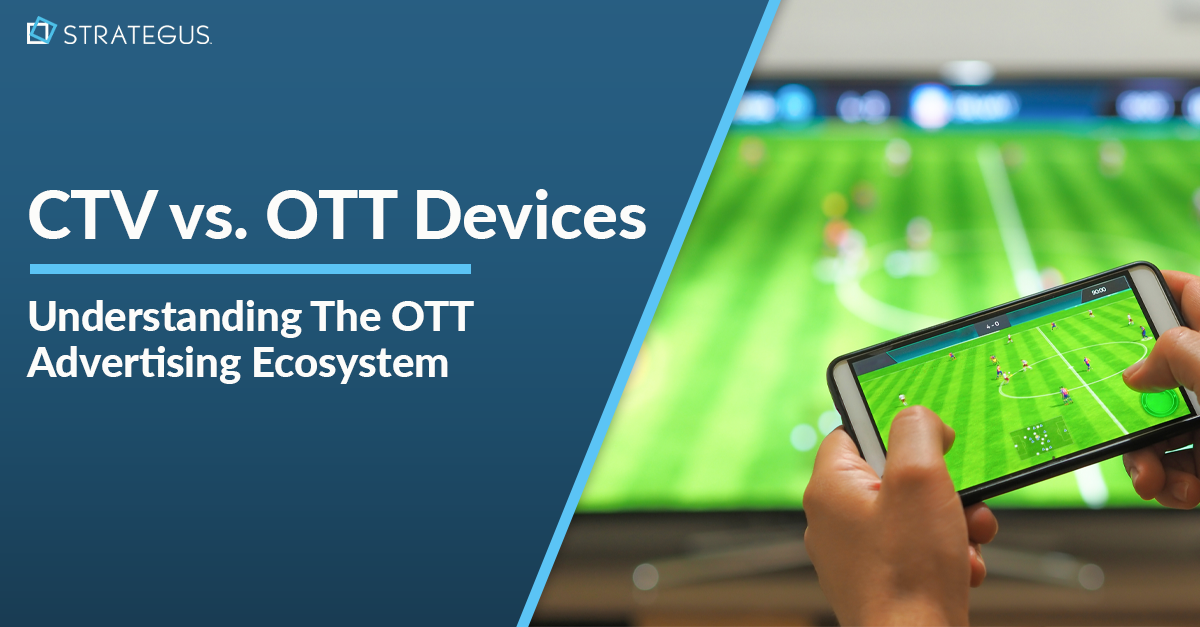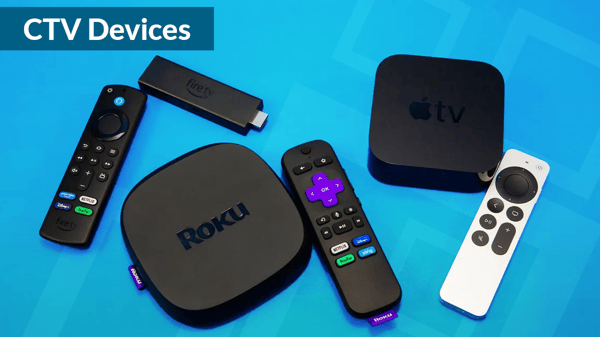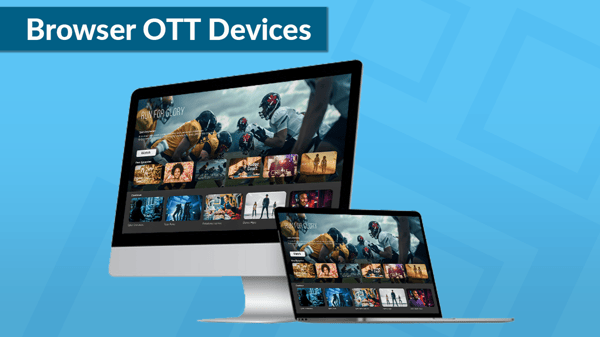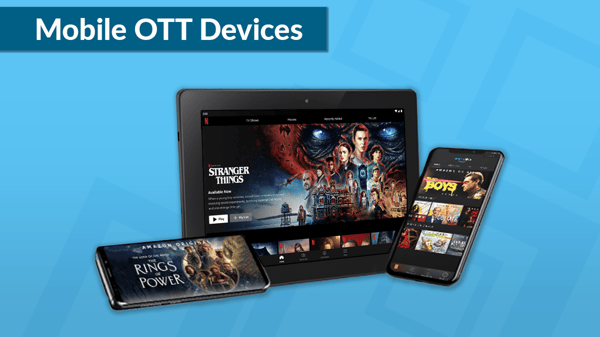- Home
- Strategus Blog
- CTV vs. OTT Devices – Understanding The OTT Advertising Ecosystem
CTV vs. OTT Devices – Understanding The OTT Advertising Ecosystem
 Andy Dixon
Andy Dixon
6 minutes read

And with the growing number of cord-cutters making the jump from traditional TV to streaming TV, the number of providers and vendors are also growing. The number of streaming services have exploded, including the introduction of Disney+, HBO Max, and Sling TV. This means that there are also more opportunities to capitalize on OTT and CTV advertising as a whole.
Because the digital advertising landscape is evolving so quickly, it can be overwhelming to stay ahead of trends and best practices. In order to be at the forefront of what is happening in this space, it is important to understand the distinction between CTV and OTT, and all of the different parts that make up this ecosystem.
To oversimplify, OTT is the way in which video is delivered, referring to content accessed directly through the internet instead of through traditional ad-supported broadcasts. CTV on the other hand, is a subset of OTT, a term generally used to reference where that content is accessed e.g. smart televisions that have internet connectivity capabilities such as Roku, Apple TV, and Fire TV.
Understanding the OTT Advertising Ecosystem, the Different Devices, Their Benefits, and Limitations
Compared to other forms of advertising such as banner ads or influencer marketing, video ads are more effective due to their capacity to make a deeper emotional impact and placement on the largest digital device in most households. This is a large factor in why OTT and CTV are trending as much as they are, despite being a relatively new field.
When you think of the broader OTT advertising ecosystem, it can seem all encompassing. After all, there are countless platforms and devices where a consumer can access content without a cable or satellite TV subscription. And considering OTT programming covers all content that is streamed over the internet, it’s crucial for marketers and media buyers to understand the various device types when strategizing for their next OTT ad campaign.
The Three Largest Device Categories and Their Pros and Cons:
CTV Devices

Examples: Roku, Apple TV, Fire TV Stick, Smart TV, Etc.
Connected TV (CTV) devices allow video content to be streamed to the television from the internet without a traditional cable connection. This includes devices with a built in operating system that allows a direct connection to the internet i.e. Smart TV with pre-installed apps, as well as devices that use the television as a display, but uses the internet to access content i.e. Firestick TV. The most popular and well known of this category are Roku and Amazon Fire TV.
The bulk of long-form viewing takes place via CTV, although it is just a subset of all the available devices that can stream OTT content. For advertisers considering a CTV campaign, here are some key things to remember:
Advantages
- Ads are not skippable
- Great household targeting using big data
- View rate and completion rates are nearly 100%
- Viewing habits are now resembling linear TV (higher ad consumption)
Disadvantages
- Not actionable since ads are not clickable — Unless you leverage a blended retargeting approach with a solution like CTV Cross-Device Retargeting.
- More difficult to track and attribute conversions (but luckily Strategus has it’s proprietary Attribution Suite, so this doesn’t apply for us)
- Audience targeting CAN BE less specific (Strategus has figured out a way around this, ask us how)
>>Between CTV and linear TV, which one is better?
Browser OTT Devices (PC’s and Laptops AKA Full Episode Player – FEP – Inventory)

Examples: Websites With Full Episode Length Content; 30-60 Minutes
As a reminder, over-the-top (OTT) services refer to video or streaming platforms that provide access to shows or movies through the internet. Some popular providers that are household names include Hulu, Netflix, Prime Video, and even YouTube. Most of these services have a web page or an app where someone can log in, allowing the content to be streamed on browser-based devices such as PCs and laptops.
Advantages
- Actionable ads, users can directly click through to the advertiser
- Simple and straightforward tracking
- Easiest attribution
- Best audience targeting (tied with mobile)
Disadvantages
- Susceptible to ad blockers
- Ads can be skipped
- Clicking skip or moving a browser window over the ad content
- Clicking skip or moving a browser window over the ad content
- Higher demand paired with shrinking audiences have caused media cost inflation
Browser Tablet/Mobile Apps (Also OTT)

Examples: iOS, Android, Hulu, Sling, YouTube, Etc.
Not surprising, considering the Pew Research Center estimates that 96% of Americans own a mobile phone. According to CNBC, it is estimated that by 2025, over 70% of internet users will access the World Wide Web strictly through their smartphones.
Advantages
- Excellent audience targeting
- Actionable ads, users can directly click through to the advertiser
- Scaled distribution
- Easy attribution and tracking
Disadvantages
- Difficult to impossible to guarantee the impressions on mobile devices
- The least premium of all placements because of screen size and far more user-generated content
- At the mercy of internet bandwidth
- Slower internet speeds may cause loading issues, impacting the ad experience
- Slower internet speeds may cause loading issues, impacting the ad experience
- The user may be multitasking and not as engaged
- Lack of standardization in mobile viewport sizes can cause display inconsistency
Note — Strategus has a caveat on mobile which is that audiences certainly can stream episodes and movies on their phone, and if an advertiser wants to be there, Strategus can offer it but does not recommend it as a campaign leader. Generally speaking, mobile CTV does not come close to replicating the living room user experience CTV devices and therefore is only included specifically when specific client KPIs demand it. Ask us why if you have any questions, we are happy to discuss this topic in more detail.
The Key Takeaway
OTT advertising is trending and it is here to stay. As it continues to grow, the market will only grow more and more saturated. For media buyers and marketers alike, it will be very important to stay ahead of best practices and remain knowledgeable of various subsections of OTT.
In the last few years alone, we have seen the introduction of more and more streaming services and new smart TV devices come onto the scene. The number of cord cutters continue to grow and CTV advertising has matured enough where viewers behavior now resembles linear TV. While this solidifies the shift towards digital ads, it also means that it is becoming more competitive. This is why it is so important to understand the benefits and limitations of each OTT device category.
Regardless of the OTT device, note that there is not going to be a one-size fits all for any campaign. The smart advertisers will have OTT strategies that leverage all available devices, playing on the advantage of non-skippable ads via CTV devices and combining it with strong audience targeting (and retargeting). Depending on the brand or user, it is important to know where the ad is being delivered, on what device it is delivered, and which actions the user takes after viewing the ad.

Andy Dixon is a seasoned Content Writing Specialist at Strategus, renowned for his expertise in creating engaging and impactful digital content. With over a decade of experience in content creation, Andy has honed his skills in a variety of niches, ranging from technology and marketing to education.
Strategus is a managed services connected TV(CTV) advertising agency with over 60,000+ campaigns delivered. Find out how our experts can extend your team and drive the result that matter most.
Talk to an Expert
Seeking a Custom CTV Strategy That Delivers?
What to read next

Third-Party Data Targeting for CTV: Benefits & Tactics
Third-party data. It’s a term that’s thrown around, and yet few take the time to detail its pros and cons — much less strategies for using...
7 minutes read

First-Party Data Targeting: Benefits and Tactics for CTV Advertising
First-party data is the information that companies collect directly from their customers rather than through intermediaries. Advertisers use this...
10 minutes read

Foot-Traffic Attribution: Tying Ad Impressions to In-Store Visits
The marketing funnel has changed. Today’s shoppers often begin researching products from the comfort of their homes and don’t set foot into a store...
8 minutes read

CTV Attribution: What It Is and How It Works
Connected TV (CTV) viewing is on the rise — and that’s good news for marketers. Not only can CTV ads be precisely targeted to individual households,...
9 minutes read















